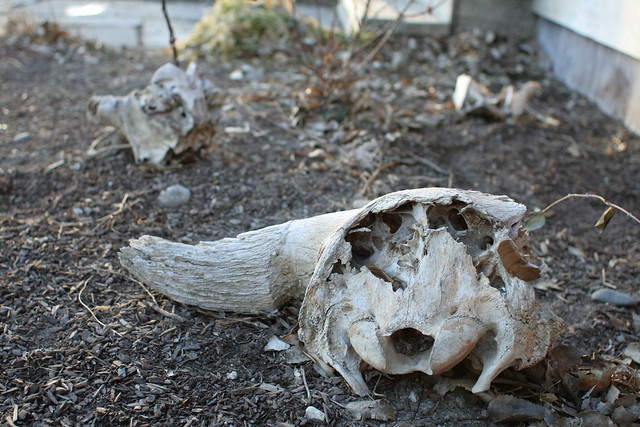I've recently had to do this with my dog Zelda, and out of curiosity I looked online. There is terrible advice out there. I thought maybe I could improve on it a little... and have illustrations!
There are many reasons to want to do this at home. I'm a stay-at-home mom, and even if I had a car during the day, it would be a pain to pack up kid and dog and drive to the vet for a five minute procedure they'd just have an assistant do.
My vet offers suture-removals as a free follow-up procedure. They don't even require an appointment for it. They often tell pet owners that they can remove sutures themselves if they feel up to it. It's probably going to be less stressful on the pet if it's done at home by familiar people.
Other reasons you may not want to bring your pet back to the vet for this simple procdure: They get stressed by travel or being at the vet; they don't like strangers touching them; you live a long distance from the vet, or work during their open hours (my vet is open on the weekends, but they're also super busy during this time).
DO NOT DO IT YOURSELF IF...
...its for a major surgery like a spay. Modern surgery techniques include "buried" sutures which dissolve on their own and MUST NOT be removed (even if you can see them peeking out of the skin a little). This guide is for simple lacerations of skin/muscle. Your vet will tell you specifically when and if sutures need to be removed (usually within 10-14 days)
...your vet wants to re-check the sutured area. Bring your pet in.
...the area is swollen, hot, and/or painful to the touch. Bring your pet to the vet ASAP if these signs appear.
...there is excessive bleeding. A small amount of blood can be normal when pulling out a suture, but if it's dripping, STOP and consult your vet. Sometimes it means the area has not healed enough yet, and sometimes it means something is wrong.
DO NOT USE hydrogen peroxide or rubbing alcohol.
These harsh disinfectants can damage tissue, plus they're needlessly painful. If the wound is ready to have sutures removed, a disinfectant is probably unnecessary. If you feel the need, use
betadine soloution or a triple antibiotic paste.
How to Remove Sutures
Step 0: Assess your pet
If they (like my dog) trust you and are used to being handled, this is a one-person job. If they unused to being handled, are nervous, young, and/or wiggly, get someone to hold them still. If they are terrified and will struggle, scream, claw, and/or bite you, leave this to professionals who, at the very least, will get the job (and stress) over with quickly.
Step 1: Assemble your stuff. You'll need:
- Good lighting
- Something to snip the suture. They make special suture scissors for this; you can also use small scissors; one of the small tools on a Swiss Army Knife would probably work; I used fingernail clippers
- Tweezers (optional)
- Damp rag or paper towel (optional)
- Treats or other reward
Step 2: Clean your instrument(s) with soapy water
Rule of thumb: make them as clean as you would a food utensil. If you're dealing with an otherwise-healthy animal and the wound is almost healed, sterilization or disinfectants are not needed.
Step 3: Dampen the area with water or betadine solution
(Optional if scabs aren't in the way) Gently loosen and remove any scabs that block your access to the suture (it's normal for scabs to completely cover sutures). If this is painful for your pet, get them good and damp and give them 10-15 minutes to soften before removing.
Step 4: Count the sutures
This sounds silly, but take it from someone who's done this countless times on a variety of different wounds that it's surprisingly difficult at times to tell if you've missed any, especially if they're hidden by scabs. You can also call your vet and ask - they should note in the chart how many sutures they put in.
Step 5: Pull up on knot
Using tweezers or your fingers, grasp the knot or one of the cut ends and gently pull up slightly. This will reveal part of the loop of suture buried in the skin.
Step 6: Cut the loop.
Cut just one side of the loop, and try not to cut the knot itself. This is the trickiest part as it requires steady hands, good vision, and the pet to hold very still
Step 7: Gently pull the entire suture free.
It may take a bit of tugging to get it out. If it's painful, leave it for a couple hours and and pull it out later.
Step 8: Reward your pet.
This thing you just did probably weirded them out. A little praise and bit of hot dog will go a long ways to letting you do this to them again in the future.
Other notes:
There are many types and sizes of suture. If it's semi-translucent
purple, blue, or brown, and is plastic-y (a bit like fishing line) then
its the type that will dissolve over time. If it's white or
cream-colored and flat and fiber-y like a ribbon, than it will not
dissolve and may be harder to snip.
If you accidentally leave part of the suture in the skin and are unable to pull it out, don't panic. If it's the dissolvable suture, it will slowly absorb over the next few months. Monitor the area daily for signs of infection. If it's the non-dissolvable, still don't panic. Call your vet for advice.
I've seen dogs try to eat the sutures/their own scabs. It's gross, but nothing to worry about.













